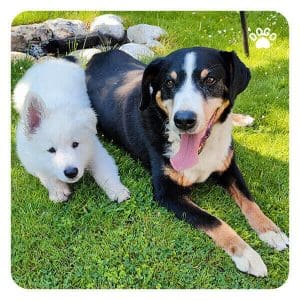
Understanding Canine Behavior
Dogs, like humans, have their own personalities, preferences, and boundaries. It’s essential to recognize that each dog has its unique way of communicating, reacting, and establishing relationships. By observing their body language, vocalizations, and interactions, you can gain valuable insights into their social dynamics. Understanding their behavior allows you to intervene effectively and create an environment where they can thrive together.
Establishing a Neutral Meeting Ground
When introducing dogs, it’s crucial to do so on neutral territory. This prevents territorial conflicts and minimizes the chances of one dog feeling threatened. Take them for a walk together, go to a park, or use an area where neither dog has established ownership. By allowing them to interact in a neutral setting, you encourage a positive first encounter, setting the stage for a potentially smoother introduction at home.
Positive Reinforcement and Patience
Creating positive associations is key to helping dogs get along. Encouraging good behavior through positive reinforcement, such as treats, praise, and affection, can help them form positive connections with each other. Be patient; building trust and rapport among dogs takes time. Avoid forcing interactions or scolding them for initial disagreements. Instead, focus on rewarding moments of cooperation and harmony.
Individual Attention and Resources
Each dog should receive individual attention, affection, and resources to prevent competition and jealousy. Ensure that they have their own food and water bowls, toys, beds, and personal space. By meeting their individual needs, you reduce the potential for conflict over possessions, territory, or attention. This also helps in preventing resource-guarding behavior, which can lead to tension between dogs.
Supervised Play and Interaction
Supervision is vital, especially during the initial stages of their interaction. Monitor their play, walks, and day-to-day interactions to intervene if tensions rise. Look for signs of discomfort, stress, or aggression, and step in to redirect their focus or diffuse potential conflicts. By being actively present, you can guide their interactions and reinforce positive behaviors.
Gradual Integration and Routine
Gradually integrate the dogs into each other’s routines and activities. This could involve feeding them in proximity, walking them together, and engaging in shared playtime. By creating shared experiences in a positive, controlled manner, you help them build familiarity and comfort with each other’s presence. Consistency and routine can provide a sense of security for the dogs, helping to reduce anxiety and potential conflicts.
Seeking Professional Assistance
In some cases, the dynamic between dogs may require professional guidance. If you’re facing persistent challenges, aggression, or anxiety in your dogs’ interactions, consulting a certified dog behaviorist or trainer can provide valuable insights and tailored strategies. Professional assistance can help address underlying issues, develop personalized training plans, and offer support in managing complex dog relationships.
Building a Harmonious Environment
Creating a harmonious environment for your dogs is a journey that demands patience, understanding, and empathy. Just as with human relationships, the bond between dogs takes time to develop and requires effort to maintain. By nurturing positive interactions, setting clear boundaries, and providing individual attention, you can foster a peaceful coexistence among your dogs, enriching their lives and your own.
In conclusion, helping dogs get along involves recognizing their individuality, promoting positive interactions, and managing their environment to minimize conflict. By approaching their relationships with patience, empathy, and proactive guidance, you can create a harmonious atmosphere where your dogs can thrive together.






